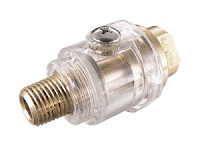Oil Air Tools the Smart, and a Little Lazy Way
The owner's manual of every air tool includes instructions on lubrication; usually something like
"place a few drops of oil into the air inlet every day" for most tools (paint sprayers excluded); maybe one or two drops if it's a grinder. So you're sure to get the point, most manufacturers include a two-ounce bottle of oil along with their nail guns, air hammers, and orbital sanders. For continuous-use tools, though, like grinders and sanders, manufacturers recommend that using in-line oilers. The moisture in compressed air has a tendency to rust the bearings and vanes of these tools, making them prone to problems, even with in-line filters.
That's why every time I hook up an air tool to my compressor - especially here on the humid Gulf Coast - there's a Craftsman 16309 Air Tool Oiler in the line; even if it's a nailer instead of a grinder.
Description
Craftsman's in-line oiler is a metal body in a clear, molded Lexan shell with a gap between inner and outer walls. The outer shell is drilled for a single screw that allows you to fill it with lightweight oil. All contacts between the metal body and fill screw with the outer wall are sealed with rubber gaskets. The whole thing is about 2" long and 1½" in diameter and weighs a couple ounces. It's machined with a ¼" NPT female thread on one end and a male thread on the other. A tiny opening connects the oil chamber to the throat of the core; air rushing past this opening sucks a mist of oil into the line as the tool works.| You can attach the oiler to the body of an air tool, or add quick-connects to the oiler and plug it into the circuit just before of the tool. That you need only buy one oiler for several tools, and just swap it out. Adding quick-connects increases the cost slightly and, more to the point, creates an makes a string about six inches long. That can be a little awkward for tight spots, but you can take the oiler out of the circuit in seconds when necessary. Does it work? Yes: I get a faintly oily feeling after running a grinder for a few minute, and the nailer exhaust feels the same. On the other hand, putting oil directly into the tool typically means blowing it all out the exhaust in the first few seconds of use. This continuous thing seems a much smarter way. |
As long as you remember to keep the oil chamber filled, you never have to oil the air tools; and they always have a protective coating of oil when you put them away after a day's work.


No comments:
Post a Comment